The Human Soul in Relation to World Evolution
GA 212
6. The Formation of the Etheric and the Astral Heart
26 May 1922, Dornach
We have often discussed the development of the human being during the first periods of life. Many years ago I first drew attention to the fact that up to about the time of the change of teeth the child behaves to a great extent as an imitative being. He instinctively participates in everything that goes on in his environment. Later in life, though man is not aware of it, this participation continues but only in the sense organs.
A process takes place in our eyes, for example, which in a certain sense imitates what goes on in the external world, reproducing what is there just as a camera reproduces what is in front of the lens. The human being becomes aware of what is reproduced in his eyes and thus learns about the external world. The same applies to the other senses. It is only in later life that this imitative principle becomes confined to the periphery of the human being. In early childhood, until the change of teeth, the whole body participates in the imitative process, though to a lesser degree. At that time the whole body has, in a certain respect, the same relationship to the external world as the senses have in later life. The child is predominantly an imitative being and he inwardly adapts to the effects upon him of the external world. Therefore, it is very important to let nothing happen in the young child's environment, not even in thoughts and feelings, which is not suitable for it to absorb and adopt.
With the change of teeth, the possibility arises for the child to cease reacting as a sense organ and assimilate thoughts and ideas. The child is more and more guided by what he is told; whereas, formerly, he was influenced by deeds done in his environment, he now begins to grasp what he is told. Authority becomes the decisive factor between the change of teeth and puberty. What the child is told must be of such a nature that he can be guided by it and follow it quite naturally. The child learns language through imitation but what is expressed through language—i.e., what grownups impart to the child—becomes significant for him only from the change of teeth onwards. Not until puberty does real power of judgment awaken and the child or adolescent begins to make his own judgment. Only then can one assume the child's judgment to originate within himself.
This is merely an external description of how the child adapts to the world, which any unbiased observation can verify. These things are, however, connected with significant inner processes of which I want to speak today. I have often mentioned that only up to the time when the change of teeth occurs does the human ether body live in intimate union with the physical body. Therefore, it can be said that the change of teeth marks the actual birth of the ether body. We can likewise speak of puberty as marking the actual birth of the astral body. But, as I said, this is merely an external description of what takes place; today we shall try to reach a deeper insight into these processes.
When we observe man in the spiritual world, long before he develops an inclination to leave that world and descend to physical embodiment, we see him as a being of soul and spirit in a world of soul and spirit. So were we all before we descended to unite with what was prepared as physical body in the maternal organism. We unite with this physical body in order to go through our earthly existence between birth and death. But long before this we were spiritual-soul beings in a spiritual-soul world. What we are and what we experience there differs considerably from what we experience here on earth between birth and death. Hence, it is difficult to describe the experiences between death and new
birth; they are utterly different from earthly conditions. Yet one can make use only of ideas and mental pictures relating to earthly experiences. However, today we will not deal so much with man's life in the spiritual-soul world—this will be the subject for tomorrow and the day after—but rather focus our attention on how he draws near his descent to earth in order to penetrate a physical body.
Before man approaches his physical body, or rather the embryo, he draws to himself the forces of the etheric world. The characteristic of the physical world we live in here, is that we perceive it through our senses and understand it with our earthly intellect. Yet everything in the physical world is permeated by the etheric world. Everything we see and hear and so on is everywhere permeated with the etheric world, the world in which man lives prior to his life on earth. Before uniting himself with the physical world, through the embryo, he draws forces from the etheric world and fashions his etheric body.
In order to represent this more exactly let me draw a diagram on the blackboard. Let us imagine this to be the soul and spirit of man approaching from the spiritual world (see drawing, violet). That which man draws towards himself from the general ether becomes his etheric body. He clothes himself, as it were, with his etheric body (orange) as he descends from the spiritual world. But to say that is to say very little. We must enter somewhat more closely into the nature of this etheric body. The etheric body which develops within man is a world in itself. One might say that it is a universe in the form of images. In its circumference it has something like stars (yellow stars), and in its lower part something reveals itself which is more or less an image of the earth. It even contains a kind of image of the sun and moon.
It is of extraordinary significance that we, in our descent into earthly life, draw together forces from the universal ether and thus take with us, in our ether body, a kind of image of the cosmos. If one could extract the ether body of man, at the moment when he is uniting himself with the physical body, we should have a sphere which is far more beautiful than any formed by mechanical means—a sphere containing stars, zodiac, sun and moon.
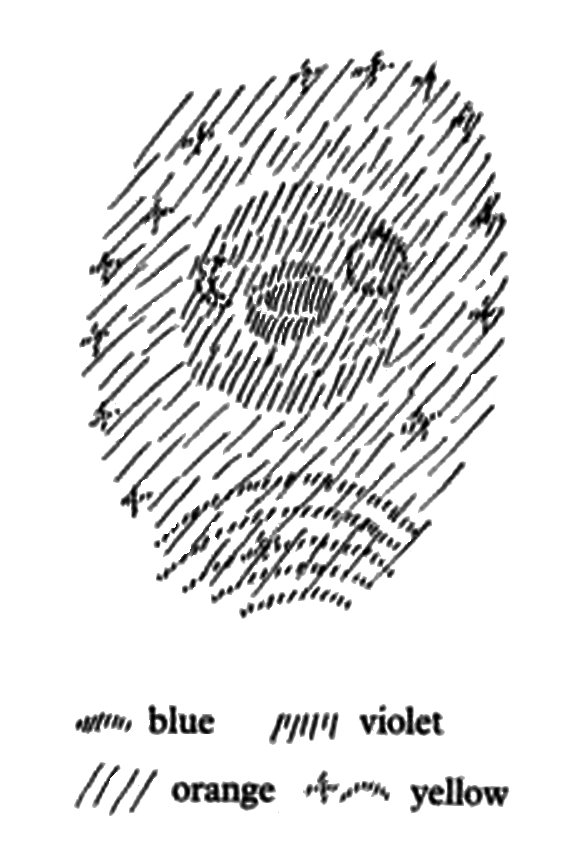
These configurations of the ether body remain during embryonic development, while the human being grows together more and more with his physical body. Though they fade a little they remain. Indeed, they remain right into the seventh year, until the change of teeth. In the ether body of a little child this cosmic sphere is always recognizable. But with the seventh year or with the change of teeth these structures, which are to be seen in the ether body, begin to ray out; up until then they were more star-like. I will make a schematic drawing of how it appears between the ages of seven and fourteen—i.e., roughly between the change of teeth and puberty (see drawing, red rays). As I said, the structure begins to grow paler during embryonic development and continues to do so but is still clearly present. From the change of teeth, it becomes quite pale, at the same time it sends rays inwards (red). One could say that the stars dissolve within the human ether body and become rays which have a tendency to come together inwardly.
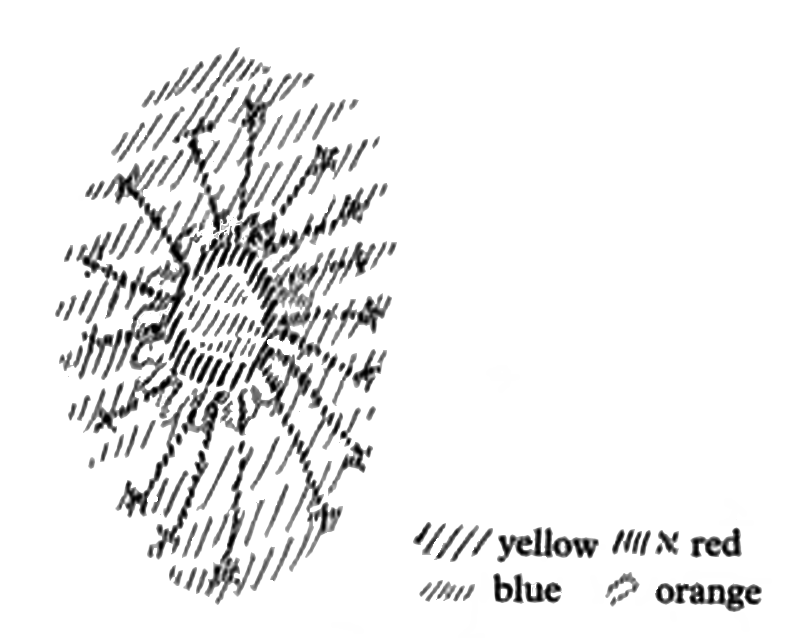
All this takes place gradually throughout the period of life between the change of teeth and puberty. At puberty the process is so far advanced that these rays, having grown together at the center, form, as it were, a distinct structure (red). It could be said that the surrounding stars become very pale and so too the rays, though something is still discernable. By contrast, what has come together into a ball-like formation in the center becomes particularly vivid and alive. Within this structure the physical heart, with its blood vessels, is suspended by the time puberty sets in (blue).
Thus, we have this extraordinary situation that the star- ether body draws inwards. As ether body it is, of course, present throughout the body but in later life it is undifferentiated at the periphery. During the time from the change of teeth until puberty it rays intensely from without inwards. It forms a center within which the physical heart is suspended.
You must not suppose that until then man has no etheric heart. He certainly has one, but one obtained differently from the way in which he acquires the etheric heart he now has. For what has thus rayed together into a center becomes, at the time of puberty, the etheric heart. The etheric heart he had before this time he had received as heritage through forces inherent in the embryo. When man gathers his ether body and with it approaches the physical organism a kind of etheric heart, a substitute etheric heart, so to speak, is drawn together by the forces of the physical body. But this etheric heart which man has in childhood slowly decays—this may not be a very nice expression, but it does fit the situation—and is replaced gradually, as the decaying processes take place, by the new etheric heart. The latter is formed by a raying together of the whole universe. In reality, it is an image of the cosmos which we bring with us as an etheric structure when, through conception and birth, we enter earthly existence. Thus, we trace, throughout the time from birth or rather conception until puberty, a distinct change in the structure of the etheric body. One can say that not until puberty is man's own etheric heart present—formed out of his own etheric body. Thus, he no longer has a provisional heart.
All the ether forces active in man up until the time of puberty have a tendency to provide him with a fresh etheric heart. It can really be compared with the change of teeth in the physical sphere. At the change of teeth, the inherited teeth are pushed out and replaced with our own. Likewise, the inherited etheric heart, which we have until puberty, is pushed out and we get our own etheric heart. This is what is essential: that we get our own etheric heart.
Parallel with this, something else occurs. When we observe man soon after his entry into the physical world, that is, when we observe a very young child, we find an extraordinary number of organs distinguishable in his astral body. As just described, man gathers together an ether body which is an image of the external cosmos. But in his astral body he brings with him an image of the experiences he has undergone between his last death and his present birth. Much, very much is to be seen in the astral body of the young child; great secrets are inscribed there. Very much is to be seen of his experiences since his last death. This astral body is extraordinarily differentiated and individual. The strange thing is that during the time when all that I have described takes place in the etheric body, the highly differentiated astral body becomes ever more undifferentiated. Originally, it is a structure of which one must say—if one observes it with understanding—that it comes from a different world. It has entered into this world from a realm that can be neither the physical nor the etheric. Up to the time of puberty all the many individual structures living in the astral body slip into the physical organs, as it were, primarily into those which are situated above the diaphragm (that is not quite exact but approximately so). Wonderful structures, radiantly present in the astral body in the first days of life, gradually slip into the brain and also penetrate the sense organs. Other structures slip into the organs of breathing, yet others into the heart and through the heart into the arteries. They do not slip directly into the stomach; but through the arteries they spread into the abdominal organs. Gradually, one sees the whole astral body, which man brings with him into physical existence through birth, dive down into the organs. The astral body slips, as it were, into the organs. One could express it by saying that by the time we reach adulthood our organs have imprisoned within them the individual structures of our astral body. This may sound strange to ordinary consciousness but it corresponds absolutely to the reality. It also provides a deeper knowledge of the human organs. One cannot fully understand the human organs unless one understands the astral body that man brings with him. One must know that each individual organ, in a certain sense, harbors within it an astral inheritance, just as the first etheric heart is an inheritance.
Gradually, the inherited astral is completely permeated by what man brings with him as his astral body. This astral body dives down, bit by bit, into the physical and etheric organs. The heart is as it were an exception. Here, too, the astral dives down; but in the heart, not only the astral process, but the etheric, too, is concentrated. This is also the reason why the heart is such a uniquely important organ for man.
The astral body becomes ever more indefinite because it sends the distinct structures it brought over from another life through birth into the physical organs in which they become confined. This causes the astral body to become more or less like a cloud. But the interesting thing is that while, on the one hand, the astral body becomes cloud-like, on the other, new differentiations enter in, slowly at first, but from puberty onwards quite regularly.
When a baby kicks with its little legs this is not particularly noticeable in the astral body. True, the effects are there but the differentiations which the astral body brought with it are so strong that the following occurs: Let this be the astral body with its wonderful structures (yellow). (This sketch is, of course, merely an indication, but it does illustrate the reality.) These structures gradually disappear; they slip into the physical organs and the astral body becomes ever more cloud-like. But, as I said, when the baby kicks, all kinds of effects are to be seen in the astral body. They
impinge upon the structures within it and from these the effects are reflected and disappear (red). It is comparable with making an impression on an elastic ball—the ball at once recovers its shape. No matter how forcefully the child kicks, while it does make impressions in the astral body they do not last. However, more and more is retained in the astral body in proportion to the child's learning to speak and form mental pictures which are retained in memory. To the extent that the child speaks and develops memory, to that extent less and less is thrown back. Rather does one see how the movements which the child now makes—no longer kicking, but reasonable movements with arms and legs and so on—are retained in the astral body. Indeed, an extraordinary amount can be inscribed in the astral body.
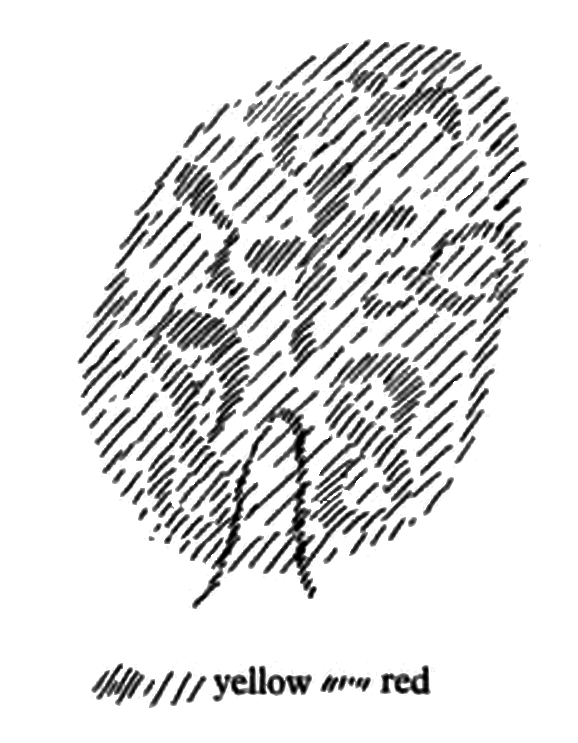
At forty-five practically all movements have left their traces in the astral body and much else besides, as we shall see. The astral body will by that time have taken up much of what has happened since the person, as a child, learned to speak and to think and the astral body's own configuration dissolved. Therefore, the wonderful structure, which the astral body of the child presents, gradually becomes undifferentiated; though not completely so, as its content disappears into the organs. Into this undifferentiated structure all the movements we make with our arms and legs are inscribed. And so, too, are the actions resulting from these movements. For example, when we guide a pen in writing, all that comes about in the external world through this action is inscribed. When we chop wood, or we give someone a box on the ear, all is inscribed into the astral body. Even when we do not do something ourselves but instruct somebody else to do it, this too is inscribed. In the latter case it happens through the relation that exists between the content of our words and the deed. In short, the whole of man's activity which finds expression in the external world is inscribed into the astral body (red in yellow). Thus, our astral body becomes differentiated in the most varied manner through our human activity. As already mentioned, this begins when the child learns to speak, endowing its speech with thoughts. Those concepts which the child receives but cannot later remember are not so inscribed. It begins only at the time to which our ordinary memory reaches back in later life. From then on practically everything a man does become inscribed in his astral body.
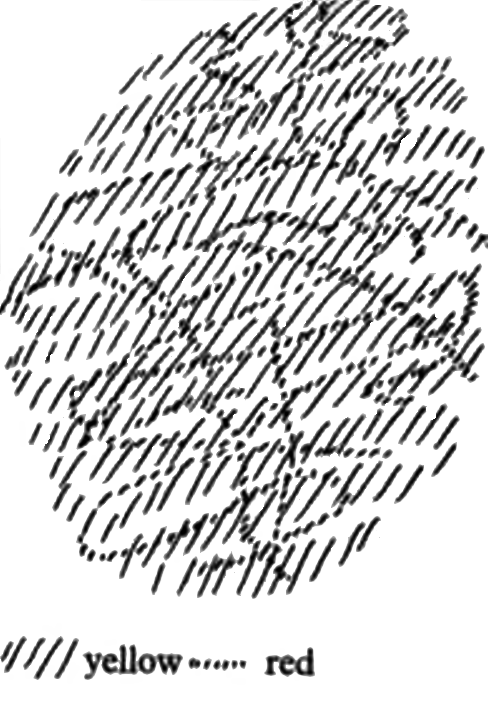
The strange thing is that what is thus inscribed has a tendency to meet inwardly just as the rays in the ether body meet in the etheric heart. All human deeds also meet there. This coming together is due to an outside cause. As human beings we must, right from childhood, engage in some activity. All this activity expresses itself as indicated throughout the astral body; but there is a constant resistance to its being inscribed. The influence on the organism cannot always take full effect in the upper part (upper part in drawing). It meets resistance everywhere in this part and is pushed down. Whatever we do with the help of our physical organs has a tendency to stream upwards to the head. But the human organization prevents this from happening by holding it back. This causes the influences to collect together and form a kind of astral center (red).
This, again, is clearly developed at the time of puberty, so that at the same place where our own—not the inherited- etheric heart formed itself we have also an astral structure which centralizes all our deeds. Thus, from puberty a central organ is created wherein all our doing, all our human activity is centered. In the same region where man has his heart the sum total of all his activity is centralized, but in this case neither physically nor etherically, but astrally. The significant thing is that at the onset of puberty—the astral process coincides only approximately with the physical process—man's etheric heart is so far prepared that it can take into itself the forces which develop from our activity in the external world. Thus, to describe what actually occurs one could say: From puberty onwards, the totality of man's actions pours, via the astral body, into the etheric heart—i.e., into the organ which is an image of the whole cosmos.
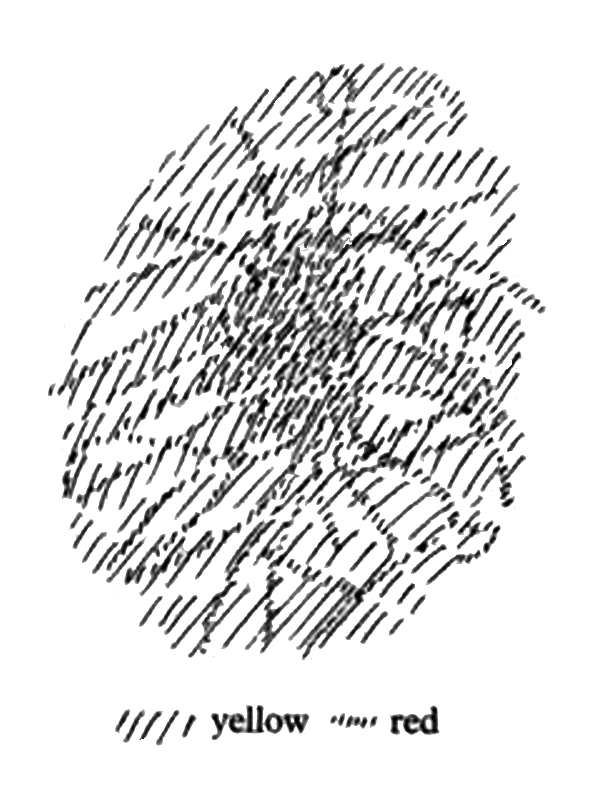
This is a phenomenon of extreme significance. When you think about it you will realize that it amounts to an interconnection of man's earthly deeds with the cosmos. You have in the heart, as far as the etheric world is concerned, a whole cosmos drawn together, and, at the same time, as far as the astral world is concerned, the totality of man's activity drawn together. This is where the cosmos and its processes join with man's karma. Only in the region of the heart is there such a close correspondence between the astral and etheric bodies and man's organism. The reality is that the ether body which man brings through birth is an image of the whole cosmos; and this essence of the
cosmos within him permeates itself with all his deeds. This flowing into one another in mutual permeation provides the opportunity for human actions continually to be inserted into the essence of the cosmic images.
When man goes through the portal of death and lays aside his physical and etheric bodies, this etheric-astral structure—within which the physical heart, as it were, swims—contains all that which man takes with him into his further soul-spiritual life. Because within the heart, in the etheric body, the substance of the whole cosmos is drawn together, man is able, as he grows spiritually larger and larger, to hand over to the cosmos his entire karma. The etheric structure, which is an essence of the cosmos drawn together in the heart, now returns to the cosmos. The human being expands into the whole cosmos and is received into the soul-world. He then continues his passage through what I described in my book Theosophy as the Soul World and Spirit Land.
When we observe the human organization in its becoming we have to say: In the region of the heart the cosmic and the earthly come together. They form a union in such a way that the configuration of the cosmos is taken into the etheric heart and there it prepares to receive all our deeds. Then when we go through the gate of death and enter a new cosmic existence, we take with us the outcome of this intimate union of the etheric and our human actions.
This is, in fact, a concrete description of how man lives his way into his physical body and how he is able to withdraw from it again through the fact that his deeds give him the force to hold together what he formed out of the essence of the cosmos.
The physical body is built up within the physical-earthly realm through heredity—i.e., through embryonic forces. With this unites that which man brings down from the spiritual world after having drawn together the ether body. This T,' which has gone through many earth-lives and has a certain development behind it, lives within that wonderful structure he has brought with him as his astral body. His T has a certain sympathy for the structures that exist in the astral body. When they slip into the organs of the physical body as described, the `I' retains this inner sympathy which now extends to the organs. (The word `sympathy' denotes the concrete reality.) The `I' expands more and more within the organs and takes possession of them. Indeed, the `I' has already in earliest childhood a relation to the organs; however, at that time the hereditary conditions are present, as I explained, and the relation is, in consequence, an external one.
Gradually the `I' and astral body slip into the organs of the physical body. This occurs as follows: To begin with the `I' has a somewhat separate existence along the bloodstream within the child, then it begins to unite ever more closely with the blood circulation until at puberty they are fully united. Thus, while you have an astral structure surrounding the etheric and physical heart (see drawing, page 94, orange), the `I' takes another path to the heart. Let us say the `I' slips into the lungs—it will then, through the veins leading to the heart, gradually approach the latter. The `I' follows the circulating blood, becoming more and more intimately united with it, so that here again, via the detour of the ego forces circling with the bloodstream, the `I' enters the structure formed by the union of the etheric and astral heart. This structure alone makes it possible for the cosmic-etheric to grow together with a human astral. I said earlier that the astral body gradually comes to contain an extraordinary amount because all our deeds are inscribed in it. But more than that is inscribed. Through the fact that the `I' has sympathy for everything concerning the astral body, our intentions—that is, the ideas on which we base our actions—also become inscribed. In this way human karma unites with cosmic laws.
Of all this taking place in man's inner being, practically nothing is known nowadays. What is known are the results of man's physical actions which are judged according to laws of nature; also known are his moral actions which are judged according to laws of morality. But man's moral and physical deeds come together in the heart. Therefore, these two things, which for man today go on side by side independently of each other, are discovered to be a unity when one learns to understand the whole configuration of the human heart. That is to say, when we understand what takes place in the heart, albeit in a much more hidden way, it is comparable to what occurs openly at the change of teeth.
We inherit our first teeth and form the second ones out of the organism. The first fall out, the second remain. The first have an inherent tendency to decay; even if they did not fall out they would not last. The reason that the second teeth sometimes decay is due to external circumstances; to these belong the external causes within the organism itself. Hidden from sight, at the onset of puberty, our inherited etheric heart succumbs to forces of decay and we acquire a kind of permanent etheric heart. Only the permanent etheric heart is fully adapted to take into itself our deeds. Therefore, it makes a great difference whether a person dies before or after puberty. When a person dies before puberty he has only the tendency to bequeath his earthly deeds to karma. Separate earthly deeds may be incorporated in their karma when children die before puberty, but these will be indefinite and changeable. The real building up of karma only begins from the moment when the astral heart has fully penetrated the etheric heart, so that the two form a unity. One could say that this union constitutes, as it were, an organism for the forming of karma; what has thus united and contracted within man, becomes after death ever more cosmic. In the next earthly life, it is again incorporated into the human being. Thus, something is incorporated in us out of the cosmos which retains the tendency to hand over our deeds after death to the cosmos. The laws that shape our karma are effective within the cosmos so that at the start of a next earthly life we carry into it the consequences of what the cosmos made of our deeds.

